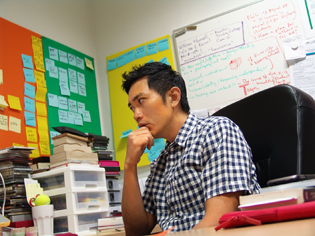Why Singapore’s English Teachers Should Embrace Singlish, Not Fight It
Is it time for Singaporean educators to embrace Singlish as a legitimate learning tool? What the Research […]
Read More
Design Thinking has been making waves in the business world and is now making inroads into education. We explore the promise of this new approach and its potential for fostering 21st century competencies in our students.
In the 1990s, big companies like Apple and P&G found themselves facing competition from smaller players. To stay ahead, they looked to design consultancies for help to improve their products and services.
Design Thinking as an approach has since spread through the business and government sectors. Educators have also begun to explore ways to infuse Design Thinking into students’ learning.
 Design Thinking is a “deeply human” process (IDEO, 2011a), even evident in the earliest inventions by mankind. At its most basic, Design Thinking is a problem-solving process. It’s thinking like a designer to create an innovative solution that addresses people’s needs.
Design Thinking is a “deeply human” process (IDEO, 2011a), even evident in the earliest inventions by mankind. At its most basic, Design Thinking is a problem-solving process. It’s thinking like a designer to create an innovative solution that addresses people’s needs.
“We should always place the people we’re trying to help at the centre and think not just about solving the technical problems, but also how people will feel when they use the solution,” says NIE Teaching Fellow Wong Yew Leong, an advocate of Design Thinking in education.
Creativity, technology and empathy all come into play as “designers” brainstorm ideas, even the most outrageous ones. The best solutions are generated through repeated trial and error, and the testing of prototypes.
Design Thinking is the confidence that everyone can be part of creating a more desirable future, and a process to take action when faced with a difficult challenge. That kind of optimism is well needed in education. (IDEO, 2011b)
Yew Leong believes Design Thinking holds the key to effective learning experiences that can equip our students with 21st century competencies.
He contends that what distinguishes the 21st century from the 20th century is that we have evolved from a knowledge economy into a design economy. “Possessing knowledge and the ability to use it in effective, efficient and predictable ways to produce reliable outcomes and incremental improvements is by itself no longer sufficient for success in the 21st century.”
For our students to thrive in this new economy, they need to be able to create innovative breakthroughs by integrating ideas from diverse fields to meet complex human needs. And since real-world problems pay no heed to disciplinary boundaries, neither should the solutions.
Yew Leong gives the example of AIDS: It is not just a medical problem for which we have to research for a cure. There are also social issues such as how to prevent AIDS from spreading in the first place.
– Wong Yew Leong, Policy and Leadership Studies Academic Group
“Design Thinking should be human-centred,” says Yew Leong. “It is to consider the entire human experience. Unless you empathize with the people whose problem you are trying to solve, you’ll be solving the problem from your own perspective rather than theirs, and they may not buy your solution even if it works.”
“Design is not airy-fairy – it’s very realistic and grounded. We always look at what our constraints are and function within that,” he adds.
Yew Leong describes Design Thinking as “the new frontier” in education. He sees potential in Design Thinking especially for cultivating 21st century competencies in students – skills like civic literacy, global awareness and cross-cultural skills, critical and inventive thinking, and information and communication skills (MOE, 2010).
“Because Design Thinking projects are so rich, they allow you to hit many educational objectives at the same time.”
However, he cautions that it doesn’t work for all subjects and all topics all the time. This is because to design, students must have in-depth understanding of fundamental principles. It shouldn’t be used to teach basic knowledge, but is particularly suited for Project Work and Community Involvement Programmes.
Yew Leong’s advice to teachers attempting this approach is to give students room to fail. “In Singapore, we don’t like to fail, but if you want to create a solution that really works, you have to fail early – that’s where you get new insights to improve.”
“You mustn’t be so concerned about protecting students from failure. A lot of teachers are protective but we must learn to step back and let students fall, and then they can learn,” he explains.
Students must also be encouraged to explore their ideas fully, and not be overly critical of themselves. They should be able to go backwards to better understand the problem and try again when their ideas and prototypes fail.
“What Design Thinking suggests is that it doesn’t matter whether your idea sounds stupid or clever or wild or crazy – put it out there and we’ll look at it, because it might trigger off something, somewhere.”
Implementing Design Thinking may be challenging, and it is going to take time. Despite this, Yew Leong believes it is worth a try.
“If we recognize that 21st century competencies are something we must teach for and the matter is urgent, if we have found a teaching strategy that works, then surely we must do it. No matter how difficult it is, we must give it a shot.”